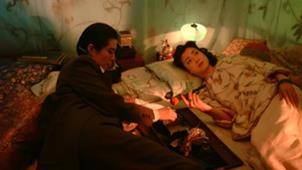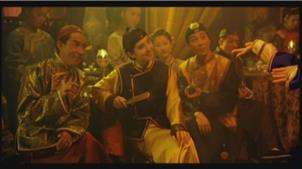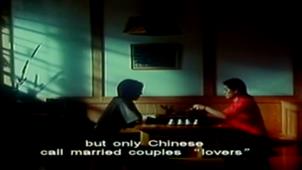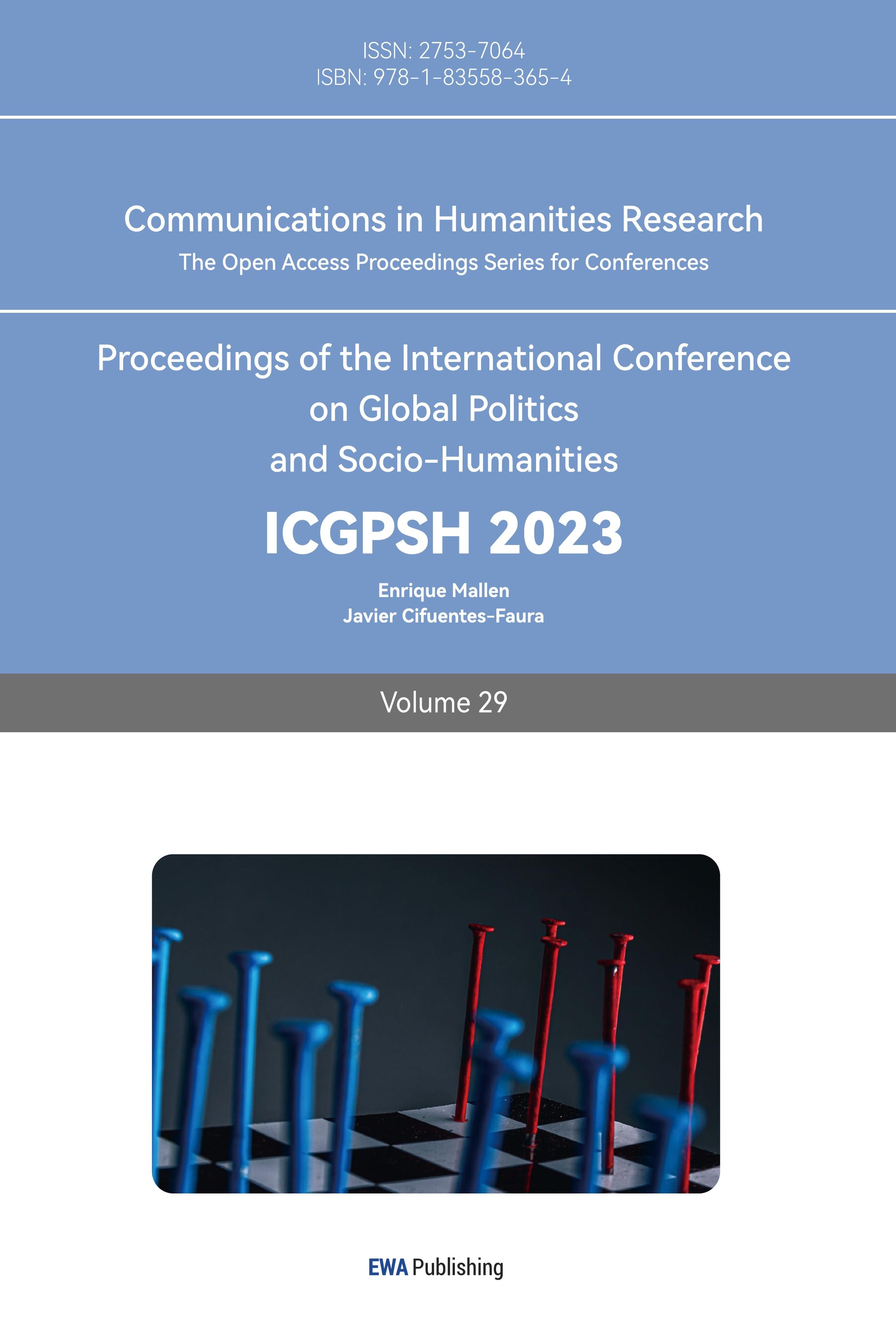1.Introduction
Filmdom has always been a man-world, much like the rest of the patriarchal society that feminists attempt to fight against. Since the rise of the second feminist wave in the 1960s, critical voices have spread like a nuclear reaction, questioning the established social order. The flourishing structuralism, combined with semiotics and psychoanalysis, has prompted feminist film theory to shift from critique of content to analysis of mechanism. In the book, And the Mirror Cracked, Anneke Smelik elaborated that "film is no longer seen as reflecting meanings, but as constructing them [1]." Before the 1960s, Simone de Beauvoir presented the most influential feminist discourse in which the male is "the One" and the female is "the Other" relative to him [2]. Drawing on Freud's formulation of scopophilia, Laura Mulvey reveals this dualism in mainstream film, which functions on the axis of activity and passivity through the male gaze [3]. The cinematic gaze allows three dimensions - character, spectator, and camera - to project erotic visual pleasure onto women. In the unidirectional identification with the male-centered subject, the female is completely objectified.
As Lacan puts it, the ego is created in the process of surrendering desire to the other [4]. The gaze becomes the expression of the ideal each gender holds for the other and for itself. Accordingly, mainstream cinema is seen to perpetuate the image of women as confined to fulfill male expectations. Hollywood, the first to bear the brunt, has long been criticized for not showing real women but only ideologically laden femininity. The female archetypes can wear a variety of masks - housewife, mistress, secretary, etc. - who are merely complements to the male protagonists. Claire Johnston, one of the pioneers who called for a counter-cinema movement, keenly perceived the dilemma: "Despite the enormous emphasis placed on woman as spectacle in the cinema, woman as woman is largely absent [5]." Women, including characters, audiences, and actresses, are caught between male domination and the resulting absurd consciousness that a perfect woman should switch easily between loving mother, accommodating wife and sexy lover. Echoing with Johnston, Smelik asserted that, "hypervisibility is a mirror reflection of invisibility." A woman's value is embodied as an appendage to a man, thus becoming the Other. To construct the counterforce, feminist filmmakers need to eliminate the spell of a patriarchal fantasy and create innovative cinematic language [6].
Changing social patterns suggest that the direction of the gaze is no longer exclusively masculine [7]. Jill Soloway, the television auteur of Amazon's hit shows, counted on the female gaze as "a sociopolitical justice-demanding way of art making" while admitting that, "there really is no such thing not yet [8]." In fact, we have embarked on the exploration of the female gaze. The controversial reversal hypothesis appeared early on the stage, which depicts men as sexual objects for consumption. In other words, the inverse roles keep the underlying structure of dominance and submission. The simply antagonistic response was soon rejected due to its convergence with the male gaze, which leads to a redistribution rather than a deconstruction of power. While the definition of the female gaze remains a fog, a 2019 drama has sparked a flash of insight.
French director Céline Sciamma claimed her work, Portrait of a Lady on Fire, to be "a manifesto about the female gaze." It portrayed a lesbian romance between an independent painter, Marianne, and an aristocratic lady, Héloïse in France during the 1770s. Marianne was commissioned to do a wedding portrait of Héloïse who was reluctant to marry. Héloïse's two portraits by Marianne were not only a vehicle to drive the narrative but also a journey to deconstruct the gaze. Unlike the dignity and solemnity shown in the second piece, the canvas initially featured a fair-skinned, well-mannered beauty. It was only under the guidance of Héloïse that Marianne escaped the aesthetics under patriarchal dominance, transforming the portrayal from a "woman to be married" to Héloïse herself. The destroyed portrait reflected how Héloïse was seen. The remade portrait, with a subtle intertextuality with Lacan's mirror stage, reflected how Héloïse expected to be seen. Comment of Tori Telfer from Vulture condensed Sciamma's reinterpretation that, "the female gaze sees people as people."
Although the phrase sounds plausible, it can only be called a description rather than a definition of the female gaze. Inspired by Sciamma, the author will dive into lesbian cinema in an attempt to define the female gaze. Since the female gaze is still an unexplored wilderness in the Chinese context, the author will study two Chinese lesbian films in depth to fill the blank. While feminism in the West spread through middle-class individualist ideologies or marginalized left-wing intellectual discourses, Chinese feminism was directly linked to central political movements [9]. Films produced under a distinct ideology may also point to a new path for the original theory.
2.Literature Review
The paper takes the female gaze as the center, lesbian cinema as the analytical text, and the Chinese context as the cultural background. The motivation for researching the female gaze is usually grounded in the deconstruction of the male gaze, which was developed by Western scholars. Re-examining the institutional context of a particular feminist practice is essential. The author has prioritized the Chinese context, whose research on the female gaze has lagged. Due to the scarcity of relevant context, the author has three books as the author’s primary sources with the keywords: Chinese lesbian cinema, women's images in Chinese cinema, and lesbians in China. In specific, Chinese Lesbian Cinema: Mirror Rubbing, Lala, and Les written by Liang Shi examines a number of Chinese lesbian films chronologically, including Fish and Elephant the author chose. In her book, Gendering China, Dai Jinhua, a pioneering Chinese feminist film scholar, outlines the changes in the image of women in Chinese cinema by combing through the historical lineage. The author uses Queer Women in Urban China by Elisabeth Engebretsen to enrich a sociological perspective, which tracks the private-public dynamic of lesbians in Beijing from 2004 to 2006.
3.Methodology
The author’s primary goal is to explore what the female gaze structures, deconstructs, and reestablishes. Given this purpose, the author will do a textual analysis of two Chinese lesbian films (produced in China and spoken in Chinese): Peony Pavilion by Fan Yon and Fish and Elephant by Yu Li. The analysis emphasizes cinematic elements, including narrative, character, cinematography, and editing, which contribute to creating a feminist discourse. Lesbian cinema developed in parallel with the emerging women's movement. Intimacy among women can be hardly tagged in terms of relationships as women's emotions are intertwined with a variety of connections, such as friendship, sisterhood, and mother-daughter bonds. This complexity provoked the debate between Jackie Stacey and Teresa de Lauretis about the definition of lesbian cinema [10]. Stacey argued that the essence of a homoerotic component in films was "a woman's obsession with another woman" even in the absence of an ostensibly sexual nature. De Lauretis object to the conflation for threatening the very existence of lesbianism, which is distinguished from other female relationships through homoerotic desire. The two scholars separately represented ambiguous lesbian cinema and openly lesbian cinema. One of the selections (Peony Pavilion) falls into the former category, and the other one (Fish and Elephant) belongs to the latter. The author will do a brief comparison after the filmic analysis of each one. Film, as a multidimensional media, negotiates between the filmmakers represented in the film, spectators evoked by the film, and broader social codes. Therefore, the author will extend the scope to the specificity of the Chinese film industry and queer culture.
4.Discussion
4.1.Textual Analysis
Peony Pavilion, produced in Hong Kong in 2001, tells the story of an educated lady who was born in an old royal family, Ronglan, and a songstress who was sold to this family, Cuihua [11]. In Fish and Elephant, produced in China mainland in 2001, a lesbian romance happened between two ordinary Beijing girls - an animal breeder and a department store saleswoman - Xiaoqun and Xiaoling [12]. Since the debate of lesbian cinema centers on homoerotic desire, the author chose the scenes where affection is aroused: the first encounter.
4.1.1.Peony Pavilion (Excerpt from 45:20 to 54:45)
Through a high-angle shot, we see Ronglan leaning on the bed and Cuihua smoking pot alongside. The room is decorated in traditional Chinese aesthetics: mahogany furniture with turquoise-colored soft furnishings. The fixed long shot allows us to digest more delicate details in the figure. Cuihua, with her hair coiled, wears a floral antique costume that complemented the overall décor, while Ronglan, in an understated suit and neat short hair, looks out of place (Figure 1). The elegant and modern image symbolizes Ronglan as an intruder into the old world as well as a rescuer of fallen women. In this way, they form a dramatic contrast that mimics heterosexual dualism - masculinity and femininity, Western and Eastern, lively and weary.

Figure 1: Ronglan and Cuihua in the Bedroom
The lingering Chinese opera in the background takes us into a flashback to when Ronglan and Cuihua first met (Figure 2). The lighting shifts the tone from calm cold to dreamlike warm, which not only separates the two timelines but also visualizes their chemistry. The relationship between the characters and the space is reversed in the theater. Surrounded by the audience, Cuihua is in the position of being watched. Dressed exactly like other men, Ronglan blends in perfectly with the setting. Yet, she then breaks the subject-object disparity by walking up to Cuihua and echoing her song. This action represents Ronglan's initiative to abandon her status as a superior. Resonance with the opera establishes a spiritual connection between the two, which temporarily frees them from the constraints of social status and ethics. In addition to the rationalization of homosexual affection, Cuihua is given the power to look back during the duet (Figure 3).

Figure 2: Ronglan in the theater

Figure 3: Ronglan and Cuihua's First Encounter
4.1.2.Fish and Elephant (Excerpt from 8:10 to 14:00)
The sunlight is cast on the face of Xiaoqun through the window, while the man sitting across from her was shrouded in darkness (Figure 4). The intensive contrast between light and shade places Xiaoqun as the absolute visual center of the figure. We can see Xiaoqun staring playfully at the man who hangs his head to avoid sight. The long wide shot along with the chorus of cicadas successfully produces a sense of dreariness during the date. The camera begins to move when it switches to Xiaoling, who is being pestered by a male customer, where the relationship between looking and being looked at is reversed (Figure 5). The compact composition conveys to us Xiaoling's displeasure at the man's rude approach. Interestingly, Xiaoling takes back the initiative in an unexpected way. We follow the camera in her footsteps straight into the women's restroom. The door not only isolates the pursuing men but also builds up a safe zone for Xiaoling to look back.

Figure 4: Xiaoqun on a Blind Date with Men

Figure 5: Xiaoling Being Pestered by a Male Customer
The montage-like editing jumps to the encounter between Xiaoqun and Xiaoling. Neither a fixed long shot nor a shaky tracking shot, we enter a point-of-view shot. Xiaoling, who had just been indifferent to the male customer's compromises, is now willing to sell her clothes to Xiaoqun at a price below cost. Xiaoqun's eyes travel back and forth between herself in the mirror and Xiaoling who is looking at her (Figure 6). At the moment, subject and object, real self and ideal projection, exist in harmony in this gaze.

Figure 6: Xiaoqun and Xiaoling's First Encounter
4.2.Lesbian Utopia
Different from Portrait of a Lady on Fire, lesbian lovers in either Peony Pavilion or Fish and Elephant are not divorced from a complex social environment. But coincidentally, the three directors deliberately create a utopia where lesbian love flows naturally: a secluded island, a back garden of the feudal gentry, and a boudoir in the middle of downtown. In an interview with Yu Li, the reason why she embedded a lesbian relationship within the total social fabric is that lesbian love is not "the love of the other" but "the love of human nature [13]." And the space where spared direct conflicts with the outside world allows the love between women and the power of women against men to coexist.
Peony Pavilion has been criticized for its bold use of reversed male gaze, as the only erotic objects displayed in the film are male. Laborers, Chinese opera singers, and Zhigang Xing, all of whom are actively or passively naked under the lustful gaze of Ronglan and Cuihua (Figure 6). Ronglan even cheats on Xing physically, and her most intimate behaviors with Cuihua are kissing hands and ballroom dancing. The controversial nature of this plot just proves that the reversal hypothesis is not convincing, because it cannot be identified as a form of female empowerment or an allusion to alienated lesbian love. In contrast, lesbianism is taken for granted in Fish and Elephant. Shi Liang, the author of the book, Chinese Lesbian Cinema, explained: "They do not have to a history to become, nor do they need a reason to exist." To demonstrate that lesbians are not the "other," and their love is not "otherness," Li Yu intentionally designs the narrative to be ordinary and even cliché. Rather than dwelling on the lovers' conflicts with society, the narrative complies with a classic human-driven structure: encounter, love, conflict, and reconciliation.
4.3.Gender in Confucian China
Confucianism remains one of the most influential philosophies in Chinese ideology, and its ideas have developed a complex relationship with gender in terms of hierarchy and marriage. The yin-yang doctrine corresponding to gender, shaped two otherwise interchangeable symbols, after which a hierarchical order is gradually implied. Yang, representing masculinity, refers to the subject and the superior; yin, representing femininity, refers to the object and the inferior. In relationships that include women, such as husband and wife, women are undoubtedly at the bottom of the order. Nevertheless, men can be in equally humble positions in other power models, such as monarch and minister or father and son [14]. Women heroes in folk culture further expand the fluidity between yin and yang, the most famous of which is Hua Mulan. She enlisted in the army in place of her elderly father by disguising herself as a man. Transgressing the gender order, Mulan is arguably an embodiment of female subjectivity for doing so through masquerade, which resonates with Ronglan in Peony Pavilion.
Combined with the feudal ideology of the time, the core of the Mulan story lies not in feminism but in filial piety. Nowadays, the promotion of the Confucian filial duty has been prominent to compensate for the government's principle that focuses on economic growth rather than social welfare. The emphasis on familial obedience is intended to stabilize a unified social structure so that the responsibility for supporting the elderly is transferred from society to the family. As such, lesbianism is seen as a threat to the patrilineal structure because it undermines the institution of marriage and violates the feminine responsibilities of wives and mothers [15]. Fish and Elephant puts this pressure under the spotlight, in which Xiaoqun is obliged to join various blind dates while hiding her sexuality from his mother.
4.4.“Tong’zhi” in socialist China
In pre-modern China, male homosexuality was allowed wide public display. Female homosexuality was suppressed to almost total invisibility, and the few historical accounts and literal texts were all written by men. Accompanied by general ignorance and misrepresentation by patriarchy, lesbianism was portrayed as a secondary option after heterosexuality, an expedient for sexual repression, and a deficient imitation to reduplicate the original heterosexual experience. In other words, lesbianism is barely another myth of patriarchal output [16]. In contemporary times, the prevalence of the generic term "tong'zhi" has given gays and lesbians a semantically equal position. Originally referred to as "comrade" in communist China, it has been now appropriated as a self-identity category of LGBT communities in mainland China and Hong Kong [17]. Unlike the fierce anti-homosexual rhetoric and legal prohibitions in many countries, the Chinese context is ambiguous. Although homosexuality was not criminalized, the Chinese Psychiatric Association did not remove it from the list of psychiatric disorders until 2001. The millennium was a turning point when homosexuality appeared in the public domain. An episode television chat show, Talk It Easy, invited the gay writer and a lesbian artist, Zien Cui and Shitou. One of the most paradoxical changes here is that the increasingly discussed topics of homosexuality in online media are banned from government-sanctioned film and television. The Norwegian anthropologist Elisabeth Engebretsen who investigated queer women in China summarized, "In a social climate characterized by official ambiguity, lack of formal protection, and widespread ignorance, it remains exceedingly difficult for queers to claim acceptance, visibility, and space [15]." In Chinese social discourse, it is more accurate to describe the situation of homosexuals as "disappearing" than as "discriminating."
4.5.“Scientific Guidance” in China
Propaganda, defined by historian Peter Kenez as "the attempt to transmit social and political values in the hope of affecting people's thinking, emotions, and thereby behavior," has been an essential element in the CCP's authority [18]. "Scientific guidance" is now the theme of CCP rule [19]. This "guidance" must be strictly adhered to, as party directives are accorded a higher status than national laws in matters relating to propaganda. The National Radio and Television Administration under the Central Propaganda Department is in charge of censoring and approving for distribution of all Chinese and foreign films. In June 2017, NRTA issued the General Rules for Auditing the Content of Network Audiovisual Programs, which inform "Network audiovisual programs containing the following contents or episodes shall be edited and deleted, including the expression or demonstration of non-normal sexual relationships, sexual behaviors, such as incest, homosexuality, sexual deviation, sexual assault, and sexual violence." Sixteen years after homosexuality was officially removed from the category of non-normative mental illnesses, it has been reclassified as "non-scientific" in cultural propaganda. Chinese lesbian cinema is apparently in plight, as evidenced above. Fish and Elephant, known as "the first Chinese lesbian film," was never officially shown inside China. Although Peony Pavilion was able to be released in Hong Kong and Taiwan due to the delicate relationship between its production venue and the central government, the box office of HK$682,025 was not satisfactory. The constraints of government censorship and the misalignment of audience preferences are a heavy blow to the creators of lesbian films, which creates a vicious circle.
5.Conclusion
The gaze need not be inherently monolithic, unidirectional, or hierarchical. The female gaze does not literally disrupt the gaze that refers to a relationship between looking and being looked at. However, it deconstructs the connection between "looking" and "subject," "activity," and "superior," as well as "being looked at" and "object," "passivity," and "inferior." In the mirror of the lesbian female gaze, one sees the reflection of the other as a complete self, not a complement of oneself. Its potential involves not only reciprocity but also a refutation of an all-encompassing male-female opposition as the decisive principle of subject formation.
Coupled lesbian protagonists, each of whom is simultaneously both subject and object of the look, occupy the primary position in lesbian cinema in parallel, thereby mirroring female spectatorship that is subversive of patriarchal heterosexist norms. The active desire of the lesbian characters is expressed through the female gaze to the spectators, particularly women, who are thus endowed with female subjectivity. De Lauretis praised lesbian cinema as a site of real liberation for all females on the off the silver screen, "where the equivalence of look and desire, which sustains spectatorial pleasure and the very power of cinema in constructing and orienting the viewer's identification, is invested in two women." Even as they disagreed on the scope of lesbian cinema, Stacey equally recognized the significance of this particular genre. She argues that the intensely intimate female bonds between the female protagonists are replicated in the connection formed between the female viewer and actresses, which involved a "homoerotic pleasure in which the boundary between self and ideal produces an endless source of fascination."
At the producer's level, the female gaze offers the once-objectified female an exit. It challenges the exclusive male privilege to the filmic gaze and reconfigures this gaze by reestablishing a new female relation to desire. The object, who was once forced into the position by the male gaze, can now utilize submission as a form of power to challenge the linear relationship with the subject. Smelik declared at the end of her book: "Feminism did crack the mirror." "Otherness" itself becomes not a regime that alienates parties involved, but a mechanism that generates coherent identity. It grows from tolerance of the "other" as other and acceptance of the self as "the other."
Lesbian cinema indeed discovers an attractive possibility of the female gaze. Yet, its reach is limited as a minor cinema [20]. The lack of mainstream lesbian representation may be attributed to commerciality and censorship. Ironically, the lesbian cinema's challenge to heterosexist hegemony and patriarchal status quo constitutes its power, while reducing its exposure. The marginalized position thus makes it difficult to promote further political emancipation. In any case, the relevance of the female gaze in lesbian cinema as an enlightening language, a sharp counterattack, and a new starting point for feminist film theory cannot be ignored.
References
[1]. Smelik, Anneke. And the Mirror Cracked: Feminist Cinema and Film Theory. Macmillan, 1998.
[2]. De Beauvoir, Simone. The Second Sex. Librairie Gallimard, 1949.
[3]. Mulvey, Laura. 1975. "Visual Pleasure and Narrative Cinema." In Film: Psychology, Society, and Ideology, 438-48.
[4]. MacCannell, Juliet Flower. Figuring Lacan: Criticism and the Cultural Unconscious. Lincoln: Routledge, 2014.
[5]. Johnston, Claire. “Women’s Cinema as Counter-Cinema.” Feminist Film Theory, 1999, 31–40. https://doi.org/10.1515/9781474473224-005.
[6]. Olayiwola, Elizabeth. 2023. “New Nollywood and the Female Gaze: Changing Female Stereotypes in Nigerian Cinema.” Quarterly Review of Film & Video 40 (1): 94–111. doi:10.1080/10509208.2021.1984822.
[7]. Goddard, K. 2000. “Looks Maketh the Man”: The Female Gaze and the Construction of Masculinity. The Journal of Men’s Studies, 9(1), 23–39. https://doi.org/10.3149/jms.0901.23.
[8]. Benson-Allott, Caetlin. “NO SUCH THING NOT YET: QUESTIONING TELEVISION’S FEMALE GAZE.” Film Quarterly 71, no. 2 (2017): 65–71. https://www.jstor.org/stable/26413865.
[9]. Hole, Kristin Lené, Dijana Jelača, E. Ann Kaplan, Patrice Petro, and Lingzhen Wang. “Chinese Socialist Women’s Cinema.” Essay. In the Routledge Companion to Cinema and Gender, 77–87. Routledge, 2019.
[10]. Hollinger, Karen. “Theorizing Mainstream Female Spectatorship: The Case of the Popular Lesbian Film.” Cinema Journal 37, no. 2 (1998): 3–17. https://doi.org/10.2307/1225639.
[11]. Yon, Fan. Peony Pavilion. Hong Kong: Intercontinental Film Distributors, 2001.
[12]. Li, Yu. Fish and Elephant. China Mainland: Venice Film Festival, 2001.
[13]. Shi, Liang. Chinese Lesbian Cinema: Mirror Rubbing, Lala, and Les. Lanham, MD: Lexington Books/Fortress Academic, 2014.
[14]. Dai, Jin-hua. Gendering China. Rye Field, 2005.
[15]. Engebretsen, Elisabeth L. Queer Women in Urban China: An Ethnography. Routledge, 2013.
[16]. Hendriks, Aart, Rob Tielman, and Veen Evert van der. The Third Pink Book: A Global View of Lesbian and Gay Liberation and Oppression. Prometheus Books, 1993.
[17]. Yue, Audrey. “Queer Asian Cinema and Media Studies: From Hybridity to Critical Regionality.” Cinema Journal 53, no. 2 (2014): 145–51. http://www.jstor.org/stable/43653576.
[18]. Kenez, Peter. The Birth of the Propaganda State: Soviet Methods of Mass Mobilization, 1917-1929. Cambridge: Cambridge University Press, 2009.
[19]. Brady, Anne-Marie. Marketing Dictatorship: Propaganda and Thought Work in Contemporary China. Lanham, MD: Rowman & Littlefield Publishers, Incorporated, 2007.
[20]. Nelmes, Jill, and Bill Nichols. “Lesbian and Gay Cinema.” Essay. In Introduction to Film Studies, 298–328. Routledge, 2012.
Cite this article
Li,A. (2024). Female Gaze of Chinese Lesbian Cinema in the Millennium. Communications in Humanities Research,29,272-280.
Data availability
The datasets used and/or analyzed during the current study will be available from the authors upon reasonable request.
Disclaimer/Publisher's Note
The statements, opinions and data contained in all publications are solely those of the individual author(s) and contributor(s) and not of EWA Publishing and/or the editor(s). EWA Publishing and/or the editor(s) disclaim responsibility for any injury to people or property resulting from any ideas, methods, instructions or products referred to in the content.
About volume
Volume title: Proceedings of the International Conference on Global Politics and Socio-Humanities
© 2024 by the author(s). Licensee EWA Publishing, Oxford, UK. This article is an open access article distributed under the terms and
conditions of the Creative Commons Attribution (CC BY) license. Authors who
publish this series agree to the following terms:
1. Authors retain copyright and grant the series right of first publication with the work simultaneously licensed under a Creative Commons
Attribution License that allows others to share the work with an acknowledgment of the work's authorship and initial publication in this
series.
2. Authors are able to enter into separate, additional contractual arrangements for the non-exclusive distribution of the series's published
version of the work (e.g., post it to an institutional repository or publish it in a book), with an acknowledgment of its initial
publication in this series.
3. Authors are permitted and encouraged to post their work online (e.g., in institutional repositories or on their website) prior to and
during the submission process, as it can lead to productive exchanges, as well as earlier and greater citation of published work (See
Open access policy for details).
References
[1]. Smelik, Anneke. And the Mirror Cracked: Feminist Cinema and Film Theory. Macmillan, 1998.
[2]. De Beauvoir, Simone. The Second Sex. Librairie Gallimard, 1949.
[3]. Mulvey, Laura. 1975. "Visual Pleasure and Narrative Cinema." In Film: Psychology, Society, and Ideology, 438-48.
[4]. MacCannell, Juliet Flower. Figuring Lacan: Criticism and the Cultural Unconscious. Lincoln: Routledge, 2014.
[5]. Johnston, Claire. “Women’s Cinema as Counter-Cinema.” Feminist Film Theory, 1999, 31–40. https://doi.org/10.1515/9781474473224-005.
[6]. Olayiwola, Elizabeth. 2023. “New Nollywood and the Female Gaze: Changing Female Stereotypes in Nigerian Cinema.” Quarterly Review of Film & Video 40 (1): 94–111. doi:10.1080/10509208.2021.1984822.
[7]. Goddard, K. 2000. “Looks Maketh the Man”: The Female Gaze and the Construction of Masculinity. The Journal of Men’s Studies, 9(1), 23–39. https://doi.org/10.3149/jms.0901.23.
[8]. Benson-Allott, Caetlin. “NO SUCH THING NOT YET: QUESTIONING TELEVISION’S FEMALE GAZE.” Film Quarterly 71, no. 2 (2017): 65–71. https://www.jstor.org/stable/26413865.
[9]. Hole, Kristin Lené, Dijana Jelača, E. Ann Kaplan, Patrice Petro, and Lingzhen Wang. “Chinese Socialist Women’s Cinema.” Essay. In the Routledge Companion to Cinema and Gender, 77–87. Routledge, 2019.
[10]. Hollinger, Karen. “Theorizing Mainstream Female Spectatorship: The Case of the Popular Lesbian Film.” Cinema Journal 37, no. 2 (1998): 3–17. https://doi.org/10.2307/1225639.
[11]. Yon, Fan. Peony Pavilion. Hong Kong: Intercontinental Film Distributors, 2001.
[12]. Li, Yu. Fish and Elephant. China Mainland: Venice Film Festival, 2001.
[13]. Shi, Liang. Chinese Lesbian Cinema: Mirror Rubbing, Lala, and Les. Lanham, MD: Lexington Books/Fortress Academic, 2014.
[14]. Dai, Jin-hua. Gendering China. Rye Field, 2005.
[15]. Engebretsen, Elisabeth L. Queer Women in Urban China: An Ethnography. Routledge, 2013.
[16]. Hendriks, Aart, Rob Tielman, and Veen Evert van der. The Third Pink Book: A Global View of Lesbian and Gay Liberation and Oppression. Prometheus Books, 1993.
[17]. Yue, Audrey. “Queer Asian Cinema and Media Studies: From Hybridity to Critical Regionality.” Cinema Journal 53, no. 2 (2014): 145–51. http://www.jstor.org/stable/43653576.
[18]. Kenez, Peter. The Birth of the Propaganda State: Soviet Methods of Mass Mobilization, 1917-1929. Cambridge: Cambridge University Press, 2009.
[19]. Brady, Anne-Marie. Marketing Dictatorship: Propaganda and Thought Work in Contemporary China. Lanham, MD: Rowman & Littlefield Publishers, Incorporated, 2007.
[20]. Nelmes, Jill, and Bill Nichols. “Lesbian and Gay Cinema.” Essay. In Introduction to Film Studies, 298–328. Routledge, 2012.









